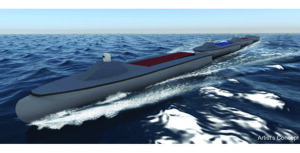News & Events

Earlier this year, the U.S. Navy released the “Unmanned Campaign Framework,” in which Secretary of the Navy Thomas Harker says, “to compete and win in an era of great power competition, the Department [of the Navy] is committed to investing in advanced autonomy, robust networks, and unmanned systems to create true integrated human-machine teaming that is ubiquitous across the fleet.” Gibbs & Cox is also committed to investing in advanced autonomy, and we have built up our specialized marine autonomy department since its establishment in 2018 in anticipation of the Navy is increasing need for unmanned vessels and artificial intelligence (AI). Our expert team of robotics and unmanned system specialists has been instrumental in our ability to provide the U.S. Navy with cutting-edge technology and service. Although we only formally established our marine autonomy group in 2018, we began implementing autonomy technology in 1955 with the U.S. Navy Sea Legs project. Sea Legs was the first vessel to successfully use actively controllable submerged-foil hydrofoils. Pitch, roll, and attitude of the boat in flight were controlled electronically by an autopilot stabilizing system. We have advanced significantly since 1955 and are proud to offer a range of marine autonomy services to help the Navy adapt to an increasingly complex security environment.

Successful unmanned system (UMS) deployment depends on a vessel’s ability to monitor, predict, and diagnose performance degradations and failures in an Hull, Mechanical & Electrical
(HM&E) system of systems while underway, and then optimize the usage of available resources. G&C offers a Modular Open System Architecture (MOSA) approach, which expands upon Unmanned Maritime Autonomy Architecture (UMAA), to provide the interface specifications needed to confidently code, deploy, and win. We envision integrating with a broader Condition-Based Maintenance Plus (CBM+) paradigm in the future to provide just-in-time system maintenance during port visits.
Gibbs & Cox understands autonomy and the challenges that accompany it, and this understanding allows us to collaborate with the right teammates to develop successful, reliable unmanned and autonomous vessels for our clients. We team with industry leaders in Hull, Mechanical & Electrical (HM&E) system design, reliability, and AI, as well as reputable shipyards, to develop and field Unmanned Maritime Vehicles that will operate for long durations without human intervention. These partnerships allow us to cultivate innovative marine autonomy solutions that will drive the future of the US Navy fleet.
